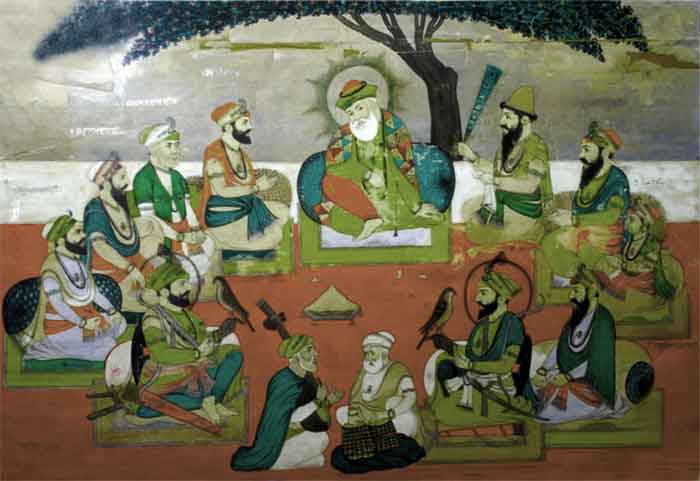
The Ten Gurus of Sikhism

The Ten Gurus of Sikhism
"India was once again blessed by God with Guru Nanak, possessed of all attributes of a prophet, a complete and perfect human being. Guru Nanak's appearance in the world was no less than that of Prophet Abraham 5000 years ago." Mohamed Iqbal
Guru Nanak(1469-1539):Compared to Buddhism and Jainism, Sikhism is of recent origin. It was founded by Guru Nanak who was born at Talwandi in the Punjab in A.D. 1469. During his life time he visited many sacred places in India, central Asia and Middle East including Mecca. He was well versed in the scriptures of all the major religions including Christianity and Judaism. He preached a liberal path, which is known today as sikhism, that derived its inspiration mainly from hinduism, but in many ways was a synthesis of both Islam and Hinduism. His teachings in the form of religious hymns are preserved in the Gurugranth Sahib, which is the sacred scripture of the Sikhs. Guru Nanak passed away in A.D.1538 and was followed by a succession of nine gurus whose names are mentioned below:
2. Guru Angad (1504-52). He is credited with the invention of Gurumukhi.
3. Guru Amardas (1552-74). It is said that he originally started the tradition of Langar, the social kitchen to remove caste distinctions and establish social harmony among his followers.
4. Guru Ramdas (1574-81). He was the son-in-law of Guru Amardas. He founded the city of Ramdaspur, which is now known as Amritsar. The construction of Guru Harminder Sahib (the Golden temple) began here during his time.
5. Guru Arjan (1581-1606). He was the youngest son of Guru Ramdas. He compiled the Adi Granth which is the most important segment of the Guru Granth Sahib. He made Sikhism very popular during his life time and there by attracted the attention of the Mughal Emperors.
6.Guru Har Gobind (1606-45). Son of Guru Arjan, he perfected the dress code introduced by his father and started the tradition of wearing two swords, one signifying his political (amiri) authority and the other his religious (fakiri). He tried to organize the Sikhs and the Hindus against the Mughals for which he had to face the wrath of the Mughal Emperor, Jehangir.
7. Guru Har Rai(1630-1661): He supported Dara Shukoh, the elder brother of Aurangazeb in his conflict with the latter and had to pay dearly for it. His son was held hostage by Aurangazeb and Har Rai could not secure his release.
8. Guru Har Krishan (1661-64): He was the second son of Guru Har Rai, who succeed his father at the age of five under unfortunate circumstances since his brother was taken away as a hostage by the Mughals. The Mughal Emperor summed him also to Delhi and he died shortly thereafter at the age of eight.
9. Guru Teg Bahadur (1675-1708): Though he was able to spread Sikhism to a greater degree, Sikhism also suffered from schism during his time. Aurangazeb executed him for his defiance of the Mughal authority. We are told that when he was in the prision awairing his execution, Guru Teg Bahadur predicted the coming of the Western powers to the Indian subcontinent and the downfall of the Mughals.
10. Guru Gobind Singh (1675-1708):He was the tenth and the last Guru and also the most famous after Guru Nanak. He was born at Patna. Because of the execution of his father, he became the Guru at the age of nine. He organized the Sikhs into Khalsa to oppose the tyranny of the Mughals. He began the tradition of adding the suffix 'Singh' to the names of the Sikhs. He introduced the baptism of the sword, abolished the succession of the Gurus and made the Guru Granth Sahib the symbol of the Guru himself. He spent most of his time opposing the Mughals to whom he lost his two sons and finally he himself was assassinated by a Pathan at Nanded in the present day Maharashtra. Swami Vivenkananda called him rightly "the most glorious hero of our race."
Suggestions for Further Reading
- Basic concepts of Sikhism
- Guru Nanak Dev
- The teachings of Guru Nanak
- The Ten Gurus of Sikhism
- Best Websites On Sikhism
- Best Websites On Sikhism, Part 2
- Sikhism - Websites and General Resources
- Websites About Sikh Organizations and Guru Dwaras
- The Guru Granth Sahib - The Holy Book Of The Sikhs
- The Sikh Religion Its Gurus - Life Of Guru Nanak - Asa Ki War
- Divine Services By Guru Nanak And Other Gurus - Japji
- Rahiras
- Additional Slokas
- The Sohila
- Hymns Of Guru Nanak, Sri Rag
- Thus Sayeth Gurbani- a Book Review With Quotations
- God in the Gurbani
- A Book Review Three Phases of Struggle
- Books On Sikhism And Sikh Faith
- Essays On Dharma
- Esoteric Mystic Hinduism
- Introduction to Hinduism
- Hindu Way of Life
- Essays On Karma
- Hindu Rites and Rituals
- The Origin of The Sanskrit Language
- Symbolism in Hinduism
- Essays on The Upanishads
- Concepts of Hinduism
- Essays on Atman
- Hindu Festivals
- Spiritual Practice
- Right Living
- Yoga of Sorrow
- Happiness
- Mental Health
- Concepts of Buddhism
- General Essays